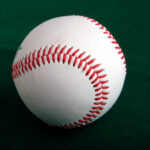Casual baseball fans know that there are several types of pitches, such as fastballs and breaking balls. However, they may not realize just how many different ways there are to throw a ball. Indeed, a discerning eye will notice that there is a wide array of pitches used in every MLB game.
Read on to learn about 10 of the most common pitches seen in baseball today:
Two-Seam Fastball: There are several varieties of fastballs, and a good fastball-pitcher can throw over 90 miles per hour with excellent control. A two-seam fastball is thrown by placing the index and middle fingers on the seams where they are very close together. This type of fastball sacrifices a small amount of speed for some sinking movement.
Four-Seam Fastball: A four-seam fastball is all about pure velocity, as it has minimal movement and is intended to challenge the batter’s reaction time. To throw one, the pitcher puts the index and middle fingers perpendicular to the seams, and the thumb makes light contact with the seam underneath the ball.
Split-Finger Fastball
: This pitch gets its name because the index and middle fingers are split far apart to form a “V” shape. It can be a very effective pitch since it appears to the batter to be a normal fastball, but when thrown correctly, it drops abruptly when it nears home plate. It’s a popular strikeout pitch for many players.
Cutter: A cutter is gripped similarly to a four-seam fastball, but the ball is held looser in the hand. This pitch is relatively slow for a fastball, though it compensates by breaking toward the pitcher’s glove hand. It’s a good type of pitch to induce grounders.
Sinker: A fifth type of fastball is the sinker. It has a lot of movement on it, and although it rarely results in a swinging strikeout, it does lead to many ground balls. There are a lot of methods to throw a sinker, but a common way is to grip the ball in a similar manner to a two-seam fastball, and then use a downward motion with the wrist.
Curve ball: Curve balls are a common type of breaking pitch, where the ball is thrown at a medium pace and sharply dips as it nears the plate. It’s not easy to throw a curveball; the middle finger is placed on one of the long seams, with the index finger alongside it. The thumb is placed behind the opposite side’s seam, and the two other fingers are folded inward. A well-thrown curveball can be difficult to hit, but a poor one that doesn’t move downward is called a hanging curve, and these result in many home runs.
Slider: Another type of breaking pitch is the slider. It’s something of a hybrid between a curve ball and a fastball. The grip for a slider is close to that of a two-seam fastball, though the fingers should be a bit off-center, where they are moved slightly toward the outside of the ball.
Straight Change: A changeup is an off-speed pitch that at first appears to be a fastball, but is actually thrown much slower. Therefore, a batter expecting a fastball will have a tough time reacting to the slower speed, and will swing way ahead of the ball. The straight change is the most common variety of changeup, and it’s thrown by gripping the ball with three fingers, with the ball held closely to the palm.
Circle Changeup: This is a second popular variety of changeup, though it includes more movement than the straight change. To throw one, the pitcher places the ball in the palm, and forms a circle with the thumb and index finger. The circle changeup doesn’t result in many strikeouts, but it’s another good way to induce grounders.
Knuckleball: Knuckleballs are very unpredictable pitches, both for the batter and the pitcher. The ball is thrown in a way to minimize spin, resulting in seemingly random trajectories. It travels at slow speeds, and although it’s rarely seen in MLB, pitchers who utilize the knuckleball tend to specialize in it. The original grip was to hold the ball with the knuckles, but methods have been developed to hold the ball with only the fingertips.






